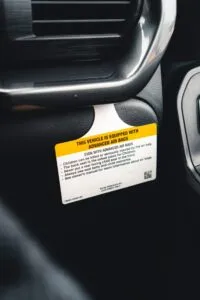
Overview of the Airbag Facts:
- Airbags deploy at speeds up to 200 miles per hour.
- Airbags are inflated by nitrogen oxide after crash sensors transmit a signal to the software requirements specification (SRS) computer.
- Frontal airbags are required in all 1999 model vehicles and beyond.
- Side airbags are not federally mandated but most cars still have them anyway
- In rare instances, airbags can still cause personal injury if you’re not careful.
- Airbags STILL save lives!
What are airbags?
How it works
For specificity’s sake, the accelerometer (located in the hood of a car) will be notified when an external force — usually another car — triggers the vehicle to come to a sudden halt. It analyzes whether the external force and the car’s deceleration are akin to hitting a brick wall. If it is, it transmits a signal to the SRS computer. When the accelerometer’s message is received by the SRS computer, it then inflates the airbags with nitrogen gas to protect car passengers from injury. The airbag deployment speed is 200 miles per hour at most according to the Florida Highway Safety And Motor Vehicles.
TL;DR: Basically, in the event of a car accident, the car’s crash sensors (accelerometers) communicate that a crash has occurred to the software requirements specification (SRS) computer, which then sends the signal to deploy the airbags.
Frontal Airbags
According to the Insurance Institute for Highway Safety, car manufacturers have been required to install frontal airbags in all model years since 1999. This has resulted in significant improvements in car crash casualties. In a thirty-year time span (1987 to 2017), the National Highway Traffic Safety Administration (NHTSA) estimated that 50,457 people were spared from death largely due to frontal airbags, further underscoring the importance of frontal airbags.
Side Airbags
Car manufacturers are not required by law to install side airbags. But according to the NHTSA, they’re still beholden to the side protection requirements set up by the federal government. This gives them incentives to install them anyway.
Sustaining Airbag Injuries
But though airbags are designed to mitigate the likelihood of sustaining an injury, in rare cases, they themselves may even cause the injury. This could be because of the following factors:
The passenger is not wearing a seat belt
As mentioned above, airbags deploy at speeds up to 200 miles per hour. Riding a car without a seat belt could cause you to come into contact against your car’s rapidly deploying airbag. Instead of serving as a cushion for you and the car’s surface area, it could work against you. It could possibly injure — or worse — kill you. Airbags are still effective in shielding you from harm’s way. However, airbags alone may not be able to save you in an accident. You need to also make sure that you’re wearing your seat belt to ensure your safety.
Takata Airbags
NHTSA sheds light on the recall placed on millions of Takata airbags as they have been found to be defective. The issue with them is that they could harm the lives of the drivers and passengers of these vehicles as they don’t respond well to extreme heat and humidity. If these airbags are not replaced, they could explode and injure the people in these vehicles. Check to see if your car is among the vehicles affected in this recall endeavor here.
Call Omega Law Group, PC
Airbags may minimize the likelihood of a personal injury, but the fact of the matter is that they could never completely eliminate it. You can do all the right things, drive a car with fully functional airbags and wear a seatbelt on top of that, and you could still be injured. When this happens, remember that you still have another tool at your disposal should you decide to pursue justice and restitution: Omega Law Group, home of the best personal injury attorneys in Los Angeles. Our team is dedicated to providing you personalized one-on-one care to help you fight the injustices that you were subjected to in an accident.
Visit our Contact Us page.





